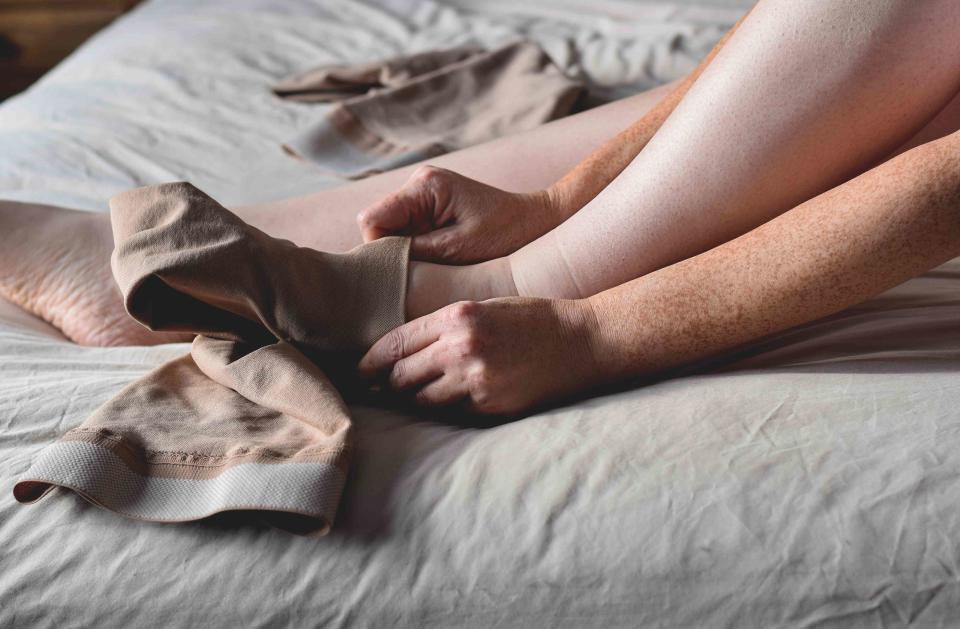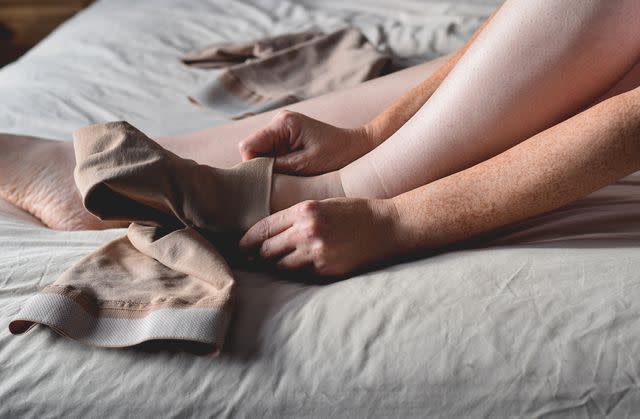How to Prevent Blood Clots
In the hospital and during recovery, travel, and other situations

JulieAlexK / Getty Images
Medically reviewed by Jeffrey S. Lander, MD
Blood clots or thrombosis can happen to anyone, but there are some situations that increase the risk of blood clots. Blood clots range in severity, from mild with pain and swelling symptoms to serious with severe illness and complications. Early detection helps prevent complications such as restricted blood supply to the veins or clotting in the lungs (pulmonary embolism). There are many ways to prevent blood clots, including walking after surgery, wearing compression socks, and staying ahead of the warning signs.
This article will explain what prevents blood clotting or how to avoid blood clots in the hospital, while laying down, and while taking certain medications, as well as other ways of preventing blood clots.

JulieAlexK / Getty Images
Can You Prevent Blood Clots?
Blood clots are preventable and treatable with early detection. Part of preventing blood clots comes down to knowing the signs. The most common symptoms that will occur in the affected body area include:
Swelling (of the whole area or particular vein)
Pain
Tenderness
Redness or discoloration of the skin
It won’t always be obvious that someone has a blood clot. About half of all people with deep vein blood clots, known as deep vein thrombosis, for example, have no detectable symptoms. This is why preventing blood clots comes down to more than monitoring for signs. There are active ways to reduce risk, even if you don’t have symptoms.
How to Prevent Blood Clots in the Hospital
If you're in the hospital after surgery, there are ways to prevent blood clots. Moving around again as soon as possible is recommended, especially if you have been on bed rest or lying down in recovery after an injury, illness, or surgery.
For people with a greater risk of developing blood clots for any reason or for people with deep vein thrombosis (DVT), compression stockings or medical compression socks are effective to help prevent blood clotting in the legs, as well as the exercises and medications discussed later in this article.
How to Prevent Blood Clots While Lying Down
There are many cases in which you may be lying down for long periods of time, including recovering in a hospital or at home from illness, injury, or surgery. If you are on bed rest for a medical condition (including pregnancy) or you live with a chronic illness that includes extreme fatigue as a symptom, there are ways to prevent blood clots.
General recommendations for people who want to prevent blood clots when sitting or remaining sedentary for long periods, (e.g., while traveling for more than four hours) include:
Getting up and walking around every one to two hours
Exercising your legs
Avoiding tight clothing (loose fit is preferred)
Exercises you can do while laying down include:
Ankle pumping, or lying on your back with your feet straight ahead and flexing your foot to move your toes. You can do 10 repetitions of this with both feet or one at a time five times per day.
Straight leg raises, or lying on your back with one leg straight and your other leg bent, pulling your toes toward your body, keeping your knee straight, and slowly lifting your leg off the bed until near parallel with your other thigh. Briefly hold the lower leg back down. Do this up to 10 times, twice a day.
Glute sitting, or lying on your back with your hands resting comfortably and tightening your butt muscles, then releasing and repeating up to 10 times for at least five times per day.
Related: Taking Blood Thinners Before, During, and After Surgery
How to Prevent Blood Clots From Medications
Certain medications, including contraceptives (birth control pills, rings, or patches) that increase estrogen or have a progesterone hormone called drospirenone, can also increase blood clot risk. For example, preliminary results from a study on blood clot risk funded by the U.S. Food and Drug Administration found a 1.5-fold increase in risk for people taking birth control with drospirenone compared to other hormone contraceptives.
Other medications that may increase the risk of blood clots include:
Tamoxifen, an estrogen blocker used in cancer treatment
Thalomid (thalidomide), an anti-cancer medication
Erythropoietin (EPT) for red blood cell production
Takeaway
People who take hormonal birth control and have additional risk factors for blood clots are at a greater risk.
Your healthcare provider may suggest different methods of birth control to prevent blood clots or reduce risk including:
Progestin-only birth control pills
Intrauterine devices (IUDs) containing progestin
Barrier methods of birth control, such as condoms or a diaphragm
Other Ways to Prevent Blood Clots
Other ways to prevent blood clots include making lifestyle changes to reduce any risk factors and maintain your health. Experts recommend the following other ways to prevent blood clots:
Avoid a sedentary lifestyle and gradually increase physical activity if necessary
Maintain a healthy weight
Follow your healthcare provider’s recommendations based on individual blood clot risk factors
Take medications as prescribed
Don't smoke (or if you do, quit)
Reduce sodium intake
Stopping Blood Clots at Symptom Onset
While blood clots are serious and can lead to disability or even death, there are several ways of stopping blood clots at symptom onset including:
Anticoagulant medications or blood thinners to reduce clotting (over-the-counter medications like Aspirin or prescription-strength)
Antiplatelet medications to reduce blood platelets from sticking and forming clots
Clot busters or thrombolytic medications to dissolve blood clots
Some people may require blood clots surgery, including those who cannot take medications for blood clots and those experiencing DVT. Surgery can include blood clot removal or the use of an inferior vena cava (IVC) filter, which is a method of implanting a catching or trapping system for blood clots to prevent them from traveling to the lungs.
Can I Take a Natural Remedy for Blood Clots?
Certain foods and natural remedies, such as horse chestnut extract, have been discussed for their potential in treating blood clots due to their effect on blood flow circulation. More rigorous research is necessary before assessing the risks versus benefits of blood clot prevention or treatment. Before taking any natural remedies or herbs for blood clots, remember that there are contraindications or adverse reactions when taking other medications, such as blood thinners or diabetes medication. Consult with your healthcare provider about any possible reactions to your current medication list.
Related: Blood Thinners: What You Should Know
If You Suspect a Blood Clot
Blood clots lead to death for around 100,000 people per year in the United States. If you suspect you have a blood clot, seek medical consultation from a healthcare provider.
When to Seek Emergency Care
If you see signs of a blood clot, consult with your healthcare provider. If you experience any of these following severe signs that could indicate a potential risk for pulmonary embolism, seek emergency care at the ER or call 911.
Shortness of breath (unexplained)
Generalized chest pain or pain while deep breathing
Feeling faint or dizzy (experiencing very low blood pressure)
Related: How Deep Vein Thrombosis Is Treated
Summary
There are many ways to prevent blood clots. Knowing the risk factors and the signs and symptoms of blood clots can help you detect blood clots early and get treatment. Risk factors include things you can modify, such as lifestyle, as well as taking certain medications. Early signs of blood clots include pain, swelling, heat, and redness.
Serious signs of deep vein thrombosis include difficulty breathing and chest pain. Any sign of a blood clot warrants consulting with your healthcare provider. If you're in doubt or experiencing signs of DVT, go to the ER or call 911. Treatment involves medications and—in some cases—surgery.

